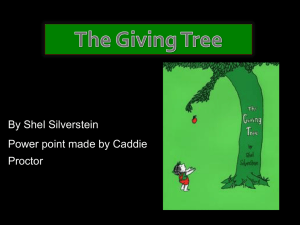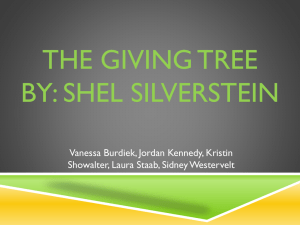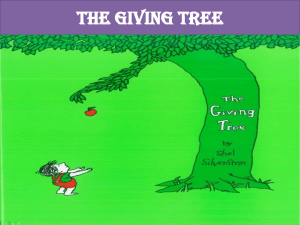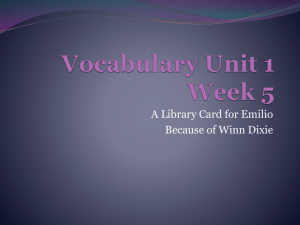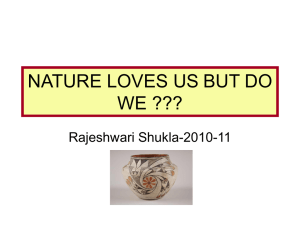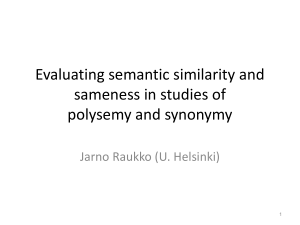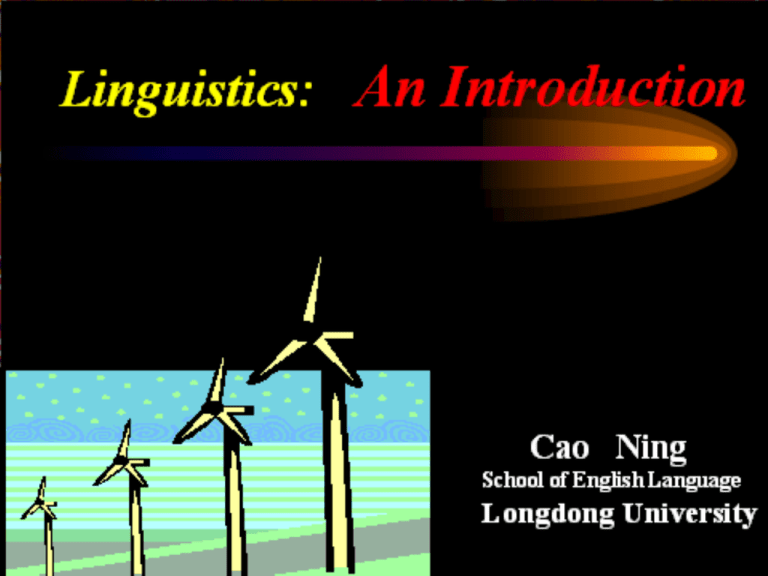
Meaning
Cao Ning
School of English Language
Longdong University
Outline
Introduction
Views on meaning
Lexical meaning
Sense relations between sentences
Analysis of meaning
What is
Semantics ?
Semantics is
generally considered to
be the study of
meaning in
language.
What does “mean/meaning” in the
following sentences mean?
John means to write.
A green light means to go.
Health means everything.
His look was full of meaning.
What is the meaning of life?
What does ‘capitalist’ mean to you?
Introduction
Meaning
What a language expresses about the world
we live in or any possible or imaginary
world.
Central semantic notion defined and used
differently depending on the theoretical
approach.
Some Views on semantics
?
One of the oldest views is the Naming Theory.
Words are names or labels for things.
In other words, the semantic relationship
holding between words and things is the
relationship of naming.
Some Views on semantics
1)
2)
Weakpoints of Naming Theories
This theory seems to apply only to nouns.
even with nouns, there will be problems,
because many nouns such as unicorn,
fairy, ghost, heaven relate to creatures or
things that do not exist.
Some Views on semantics
Conceptualism
According to this theory, there is no direct link.
between symbol and referent (between
language and the world). The link is via thought
or reference, the concepts of our minds.
It holds that meaning should be studied in
terms of situation, use, context – elements
closely linked with language behavior. … the
meaning of a word is its use in the language
(proposed by J. R. Firth).
This can be best illustrated by the Semiotic
Triangle advanced by Ogden and Richards.
Thought or Reference
Symbol
Referent
Thought or Reference
concept
Linguistic
elements
Symbol
such as
words or
sentences
Referent
The object, etc, in the
world of experience
Weakpoints ?
This theory raises a new
problem. For example, what
is precisely the link between
the symbol and concept?
Context and behaviorism
During the period roughly from 1930 to
1960, linguists gave pre-eminence to the
empirical or observational aspect in the
study of meaning.
This theory holds that meaning should be
studied in terms of situation, use, context--elements closely linked with language
behavior.
Context and behaviorism
Firth, the leading British linguist of the
period held the view that “ We shall know
a word by the company it keeps.”
a piece of paper
a daily paper
an examination paper
a white paper
a term paper
Behaviorist theory
According to Bloomfield, the meaning of
a linguistic form should be viewed as “ the
situation in which the speaker utters it,
and the response which it calls forth in the
hearer.”
Behaviorist theory
the famous account of Jack and Jill
S
r
s
Events before
speech
Speech
R
Events after
speech
S
r
s
Events before
speech
R
Events after
Speech
speech
Bloomfield argued that meaning consists in
the relation between speech and the practical
events S and R that precede and follow it.
Mentalism
This approach has been headed by Chomsky
since 1960’s.
Mentalists believe that data needed for the
study of language can be supplied by direct
resort to intuition.
They argue that people often judge which
sentences are synonymous, which sentences
are ambiguous, which sentences are illformed or absurd, based on their intuition.
Mentalism
Therefore they regard the task of
semantics mainly as one to explain those
data supplied by direct resort to intuition
by constructing theories.
Geoffrey Leech (1974, 1981). Semantics: The
Study of Meaning. Seven types of meaning:
– Conceptual meaning
– Connotative meaning
– Social meaning
Associative
– Affective meaning
Meaning
– Reflected and meaning
– Collocative meaning
– Thematic meaning
(1) Conceptual meaning
Also called ‘denotative’ or
‘cognitive’ meaning.
– Refers to logical, cognitive
or denotative content.
– Concerned with the
relationship between a
word and the thing it
denotes, or refers to.
(2) Connotative meaning
The communicative value an expression has by
virtue of what it refers to, over and above its
purely conceptual content.
– A multitude of additional, non-criterial properties,
including not only physical characteristics but also
psychological and social properties, as well as
typical features.
Involving the ‘real world’ experience one
associates with an expression when one uses
or hears it.
– Unstable: they vary considerably according to
culture, historical period, and the experience of
the individual.
Any characteristic of the referent, identified
subjectively or objectively, may contribute to
the connotative meaning of the expression
which denotes it.
Step mother
(3) Social meaning
What a piece of language conveys about the
social circumstances of its use.
– Dialect: the language of a geographical region or of a
social class.
– Time: the language of the 18th c., etc.
– Province: language of law, of science, of advertising,
etc.
– Status: polite, colloquial, slang, etc.
– Modality: language of memoranda, lectures, jokes, etc.
– Singularity: the style of Dickens, etc.
domicile: very formal, official
residence: formal
abode: poetic
home: general
steed: poetic
horse: general
nag: slang
gee-gee: baby language
(4) Affective meaning
Reflecting the personal feelings of the speaker,
including his attitude to the listener, or his
attitude to something he is talking about.
– You’re a vicious tyrant and a villainous reprobate,
and I hate you for it!
– I’m terribly sorry to interrupt, but I wonder if
you would be so kind as to lower your voices a
little.
– Will you belt up.
(5) Reflected meaning
Arises in cases of multiple conceptual meaning,
when one sense of a word forms part of our
response to another sense.
– When you hear ‘click the mouse twice’, you think of
Gerry being hit twice by Tom so you feel excited.
Many taboo terms are result of this.
(6) Collocative meaning
The associations a word acquires on
account of the meanings of words
which tend to occur in its
environment.
– pretty: girl, boy, woman, flower, garden,
colour, village, etc.
– handsome: boy, man, car, vessel,
overcoat, airliner, typewriter, etc.
(7) Thematic meaning
What is communicated by the way in which a
speaker or writer organizes the message, in
terms of ordering, focus, and emphasis.
–
–
–
–
Mrs. Bessie Smith donated the first prize.
The first prize was donated by Mrs Bessie Smith.
They stopped at the end of the corridor.
At the end of the corridor, they stopped.
Sense
Sense relates to the complex system of
relationships that hold between the
linguistic elements themselves; it is
concerned only with intra-linguistic
relations.
Pairs of words can be formed
into certain patterns to
indicate sense relations.
C o w / h e l l o , s o w / b o a r,
ewe/ram, mare/stallion etc.
form a pattern indicating a
meaning related to sex.
Duck/ducking, pig/piglet,
dog/puppy, lion/cub, etc.
form another pattern
indicating a relationship
between adult and young.
Narrow/wide, male/female,
buy/sell, etc. show a different
pattern related to opposition.
Sense relations
In fact, when we are talking of sense
relations, we are talking of
Synonymy
antonymy
hyponymy
polysemy
homonymy
buy/purchase
thrifty/economical/stingy
autumn/fall
flat/apartment
tube/underground
Synonymy
Synonymy refers to the sameness or close
similarity of meaning.
e.g. buy / purchase
world / universe
brotherly / fraternal
! But total synonymy is rare, The so-called
synonyms are all context dependent.
Synonymy
Context plays an important part in deciding
whether a set of lexical items is synonymous.
" What a nice
of flowers!“
The items “range, selection, choice,” etc. are
synonymous.
Sense relations
" His
of knowledge is enormous!"
Range, breadth, etc. are synonymous
Sense relations
Difference in meaning
amaze
and astound form a pair of
synonyms. Both suggest great wonder or
bewilderment in the face of something that
seems impossible or highly improbable.
A teacher was amazed to find that a lazy
student had gained a mark of 100 in an
important test.
A woman may be astounded to learn that her
dearest friend has been spreading malicious
gossip about her.
Sense relations
But
they differ in degrees of wonder or
bewilderment. Amaze denotes
difficulty of belief and astound
extreme difficulty of belief.
Sense relations
“Anger, rage, fury, indignation and wrath”
are synonymous in denoting the emotional
excitement induced by intense displeasure.
Sense relations
"Anger" , the most general term, describes
merely the emotional reaction; the word
itself suggests no definite degree of
intensity, and carries no necessary
implication of outward manifestation;
" to conceal one's anger",
" Tom is easily aroused to anger."
Sense relations
"Rage" often implies a loss of self-control.
" fury" , the strongest word in the group,
suggests a rage so violent that it may
approach madness.
The insolence of the waiters drove him into
a rage, and he flung his plate to the floor
and stalked out of the restaurant.
Mad with fury, John pounded his fists on
the wall and beat his breast.
Sense relations
"Indignation" denotes anger based on a
moral condemnation of something felt to
be wrong and unfair; e.g.
Abolitionists viewed the institution of
slavery with indignation.
Mary expressed her indignation at being
unfairly dismissed.
Sense relations
English is particularly rich in synonyms for
the historical reason that its vocabulary has
come from two different sources, from Anglo Saxon on the one hand and from French, Latin
and Greek on the other.
Sense relations
Since English is considered to be a Germanic
language from a historical point of view, with
Anglo-Saxon as an earlier stage of its
development, the "Anglo-Saxon" words are
often considered "native" while those from
French, Latin or Greek are “foreign”,
“borrowed” from these languages.
Couplets
Borrowed words
Answer
reply
homely
domestic
might
power
buy
purchase
fiddle
violin
Couplets
Borrowed words
brotherly
fraternally
bodily
corporal
house
mansion
hearty
cordial
driver
chauffeur
Triplets
Native
French
Latin
kingly
royal
regal
time
age
epoch
rise
mount
ascend
fast
firm
secure
native
French
Latin
belly
stomache
abdomen
holy
sacred
consecrated
fire
flame
conflagration
fear
terror
trepidation
ask
question
interrogate
A) dialectal synonyms
Synonyms belonging to different
dialects of the language
British English
American English
coach
bus
garage
Service station
Car park
parking lot
Lay-by
Rest area
tube
subway
British English
American English
Call box
Telephone booth
telephonist
operator
vest
undershirt
pavement
sidewalk
petroleum
gasoline
B) words differing in styles or registers
Words having the same cognitive meaning
but having different stylistic meanings
Sense relations
Penalties for overdue books will be strictly
enforced. (written)
You have got to pay fines for overdue books.
(spoken)
They made a decision to abandon the project.
(formal)
They decided to walk out on the project.
(informal)
Sense relations
to chide (literary )
to berate ( neutral )
to scold ( neutral )
to blame ( neutral )
to carpet ( colloquial, esp. BrE )
to tell off ( colloquial )
to bawl out ( AmE, slang )
Sense relations
man (neutral )
chap ( colloquial )
fellow ( colloquial )
bird ( colloquial )
guy ( slang )
bozo ( slang )
Sense relations
domicile (very formal)
residence (formal)
abode (poetic)
home (general)
Sense relations
steed (poetic)
horse (general)
nag (slang)
gee-gee (baby talk)
Sense relations
C) words differing in emotive or
evaluative meaning
"little" and "small"
are synonyms. But
if any emotion is
associated with the
designation, we
must choose "little".
Sense relations
" A small boy" is as good English as " a little boy."
Yet if you should exclaim" *Poor small boy!", the phrase
is unidiomatic, because the word "small" has no
affective meaning.
Isn't he•a little•devil!•(indicating affectionate regard).
What a pretty little house!
That poor little girl! (indicating sympathy)
...She is a nice little thing ( indicating tenderness or
regard, but possibly patronage, or a feeling of
superiority)...."
appreciative
derogative
frugal
miser
bravery
foolhardiness
Firm
bigheaded
statesman
politician
intellectual
egghead
Sense relations
D) collocationally-restricted synonyms
These words can be considered as synonyms
only when they occur in conjunction with
certain words.
Sense relations
rancid, addled, sour, rotten
rancid bacon
rancid butter
addled egg
sour milk
rotten butter and egg
Sense relations
a flock of, a heard of, a school of, a pride of
a flock of sheep
a heard of cows,
a school of whales,
a pride of lions
Sense relations
accuse...of, e.g.
The policemen accused him of the arson.
charge...with, e.g.
At the meeting he charged his opponent
with evasion of the basic issues.
Sense relations
rebuke...for, e.g.
The teacher rebuked the student for being
impudent.
reproach...with or for, e.g.
He reproached me with ( or for ) extravagance.
Sense relations
pretty
handsome
girl
child
flower
garden
colour
village
cottage
boy
man
car
table
overcoat
airliner
house
Sense relations
sail a small boat
navigate a liner
teach arithmetic
inculcate doctrine
scholarly intelligence
animal cunning
offering to a church
dole to the unemployed
Sense relations
Antonymy
Antonymy is a standard technical term
used for oppositeness of meaning between
lexemes.
Sense relations
A) gradable opposites ( contraries)
a. They will show different degrees of a
given quality.
b. They can be qualified by adverbials of
degree.
c. Since contraries are gradable, the
semantic contrast in a contrary pair is
relative; i.e. there are often intermediate
terms between the two opposites.
Sense relations
Thus we have not just rich and poor, but
there are such gradations as rich, well-to-do,
well-off, moderately wealthy, comfortably
off, hard up, poor.
poor
0
rich
25
50
75
100...
Sense relations
d. Since they show different degrees
of a given quality, they will allow a
middle ground between them.
poor
rich
0
50
100...
e. The negation of one does not mean
the assertion of the other.
“ He is not rich”
does not mean
“he i s poor.”
Sense relations
They can be used in the structure
“ neither…nor:
for example:
I am neither rich nor poor.
Gradable antonymy
good ----------------------- bad
long ----------------------- short
big ----------------------- small
– Can be modified by adverbs of degree
like very.
– Can have comparative forms.
– Can be asked with how.
Sense relations
f. This kind of antonyms can be analyzed in
terms of markedness (标记)
“markedness” is a term originally used to
analyse grammatical meaning, for example,
“book ” is unmarked(无标记词) ;
“books” is a marked word(有标记词)
because it has a marker “s” to show the
grammatical meaning of plurality.
Sense relations
Now the terms “marked” and “unmarked”
have been widely used in the analysis of
meaning. A word is unmarked if it is
semantically inclusive, or broader in
meaning while a word is marked if it is
semantically narrower.
Sense relations
Unmarked ( long)
Marked(short)
Unmarked (long)
Length of the scale
Sense relations
Very
often this kind of antonyms are not
symmetric in meaning.
well, badly
A. How badly do you speak English?
B. Very well
C. Very poorly
D. Like a native.
Sense relations
old/young
heavy/light
Wide /narrow
deep/shallow
far/near
long/short
Complementary antonymy
alive
: dead
male : female
present : absent
innocent : guilty
odd
: even
pass : fail
boy : girl
hit : miss
Sense relations---Antonymy
Complementarity
Antonyms which can not be compared to
determine whether they have the same
degree of a certain property are called
ungradable opposites. Complementarities
are very often ungradable opposites.
Sense relations
The negation of one is the assertion of the
other.
For example: alive/dead
“ He is not alive” means “ He is dead”.
Sense relations
They can not be used in the structure
“ neither…nor” because they do not allow
possibilities between them, for example:
I am neither alive nor dead.
Sense relations
More examples:
male/female
married/single
boy/girl
brother/sister
Converse antonymy
buy
: sell
lend : borrow
give : receive
parent : child
husband : wife
teacher :
student
above : below
before : after
host : guest
employer : employee
Sense relations
Relational opposites (Conversives)
They express the reversal of a relationship
between items or a contrast of directions.
Usually there is an independence of
meaning. One member of the pair
presupposes the other member. Therefore
they form a unity of opposites.
Sense relations
If A sells a watch to B, B buys a
watch from A.
If A gives a pen to B, B
receives a pen from A.
If A lends money to B, B
borrows money from A.
Sense relations
More examples?
husband/wife
fiance/fiancee
parent/child
above/below
debtor/creditor
Hyponymy
Inclusiveness
A is included in / a kind of B.
Cf.: chair and furniture, rose and flower
– Superordinate/hypernym: the more general term
– Hyponym: the more specific term
– Co-hyponyms: members of the same class
Animal
bird fish insect animal
human
animal
tiger lion elephant ...
Sense relations
Very often a word is polysemous in
nature, therefore, a word may have
different corresponding antonyms,
for example:
Fresh bread/stale bread
fresh air/stuffy air
fresh flowers/faded flowers
Polysemy and homonymy
Sense relations
Homonymy
In the English language, there are
many pairs or groups of words, which,
though different in meaning, are
pronounced alike or spelled alike, or
both. Such words are called homonyms
Sense relations
A. Types of homonyms
English homonyms are classified as
follows:
1. Perfect homonyms: words identical in
sound and spelling but different in
meaning are called perfect homonyms;
Sense relations
lie vi make a statement that one
knows to be untrue;
lie vi be, put oneself flat on a
horizontal surface or in a
resting position;
page n. one side of a leaf of paper in
a book, periodical, etc.;
page n. boy servant, usu. in uniform,
in a hotel, club, etc.;
Sense relations
base n. the thing or part on which
something rests;
base adj. having or showing little or no
honour, courage or decency;
meet vt. to come upon or encounter;
meet n. a meeting, gathering, or
assembling as for a sporting
event
Sense relations
2. Homophones:
Words identical in
s o u n d b u t
different in
spelling and
meaning are
c a l l e d
homophones.
Sense relations
air,
heir;
ear,
bare;
Sense relations
pair,
pear;
son,
sun;
Sense relations
compliment,
complement;
principal,
principle;
stationary,
stationery,
Sense relations
3. Homographs: Words identical in
spelling but different in sound and
meaning are called homographs: e.g.:
lead /li:d/
v. guide or take, esp. by
going in front, etc.
lead /led/ v. easily melted metal of a
dull bluish-grey colour
Sense relations
sow/s u/ v. put (seed) on or in the
ground or in soil;plant
(land with seed)
sow /sau/
n. a fully grown female
pig
tear /ti / n. drop of salty water
coming from the eye
tear / / v. pull sharply apart or to
pieces
Sense relations
Polysemy
Sense relations
The word Polysemy is of Greek
origin (GK polys, much + sema,
meaning). It has been defined as
"...A term used in semantic
analysis to refer to a lexical item
which has a range of different
meanings ( Crystal 1980:274)."
Sense relations
The ability of one word to denote several
senses is one of the basic peculiarities of
human speech. A glance at any English
dictionary will give you an idea of how
frequent polysemy is. One -meaning
words (monosemic words) are very rare.
They are very often scientific terms (e.g.
oxygen, moonwalk, and earthrise).
Sense relations
fair: (of attitude, behavior ) just and
honest
( of results ) average, quite good
( of the weather ) clear and sunny
( of amount ) satisfactory, abundant
( of the skin, hair ) pair; light in
colour
Sense relations
Sources of polysemy
A. Shifts in application
Words have a number of different
aspects according to the contexts
in which they are used.
Sense relations
Shifts in application are particularly
noticeable in the use of adjectives
since these are apt to change their
meaning according to the noun they
qualify. The adjective " handsome",
for example, has been used, in the
course of its history, in the following
sense, grouped according to the noun
to which they refer:
Sense relations
Persons:
a) apt, skilled, clever
b) proper, fitting, decent
c) beautiful with dignity
Concretes:
a) easy to handle
b) of fair size
c) beautiful with dignity
d) proper, fitting ( of dress )
Sense relations
Action, speech:
a) appropriate, apt, clever
Conduct:
a) fitting, seemly
b) gallant, brave
c) generous, magnanimous
Sense relations
Sizes, sums:
a) fair, moderately large
b) ample, liberal, munificent
Sense relations
B. Specialization in a social milieu
Polysemy often arises through a kind of
verbal shorthand. For a lawyer, "action"
will naturally mean legal action; for the
soldier it will mean a military operation,
without any need for a qualifying epithet.
In this way the same word may acquire a
number of specialized senses, only one of
which will be applicable in a given milieu.
Sense relations
C. Figurative language
Many inanimate objects
are compared to the
parts of the human body.
Sense relations
the eye of a needle 针眼
the eye of a potato马铃薯的芽眼
the eye of the hurricane 风眼
the eye of a flower
花心
the eye of a peacock’s tail孔雀翎斑
the eye of the revolution 革命中心
Sense relations
A p i g : a d i r t y,
greedy or illmannered person
An ass: a stupid
foolish person
Sense relations
A mouse: a person, esp. A woman,
who is quiet and timid
A goose: a
silly person,
esp. female
Sense relations
A cat: a nasty person
A rat: a low
worthless
disloyal man
Componential analysis
Componential Analysis (known as CA)
meaning is composed of meaning components
called semantic features. Plus and minus signs
are used to indicate whether a semantic feature is
present or absent in the meaning of a word. e.g.
woman: +HUMAN, +ADULT, +ANIMATE, - MALE
man: +HUMAN, +ADULT, +ANIMATE, +MALE
boy :
+HUMAN, - ADULT, +ANIMATE, +MALE
Componential Analysis
HUMAN
– man (ADULT, MALE)
– woman (ADULT, FEMALE)
– boy (NON-ADULT, MALE)
– girl (NON-ADULT, FEMALE)
Animal words
MALE
FEMALE
NON-ADULT
bull
cow
calf
ram
ewe
lamb
boar
sow
piglet
English motion verbs
ONE FOOT
NATURAL HURRIED FORWARD ALWAYS ON
GROUND
walk
+
━
+
+
march
━
+
+
+
run
━
+
+
━
limp
━
━
+
+
More complex ones
father: PARENT (x, y) & MALE (x)
– x is a parent of y, and x is male.
take: CAUSE (x, (HAVE (x, y)))
– x causes x to have y.
give: CAUSE (x, (~HAVE (x, y)))
– x causes x not to have y.
Sense relation between sentences
I. X is synonymous with Y, e.g.
X: I am an orphan.
Y: I am a child and have no father or mother.
X: I am an orphan.
Y: I am a child and have no father or mother.
In terms of truth condition, If X is true, Y is true,
and if X is false, Y is false.
e.g. X; He was a bachelor all his life.
Y: He never married all his life.
X: The boy killed the dog.
Y: The dog was killed by the boy.
X is inconsistent with Y
e.g. X: I am an orphan.
Y: I have a father.
In terms of truth condition, if X is true, Y is
false, and if X is false, Y is true.
e.g. X: John is married.
Y: John is a bachelor.
X: This is my first visit to your country.
Y: I have been to your country before.
X entails Y.
(Y is an entailment of X.)
e. g. X: I am an orphan.
Y: I have no father.
In terms of truth condition, if X is true, Y is
necessarily true; if X is false, Y may be true or
false. If Y is true, X may be true or false; If Y is
false, X is false.
e. g. X: John married a blond heiress.
Y: John married a blond.
X: He has been to France.
Y: He has been to Europe.
If X is true, Y is necessarily true, e.g. If he has
been to France, he must have been to Europe.
If X is false, Y may be true or false, e. g. If
he has not been to France, he may still have
been to Europe or he has not been to
Europe.
If Y is true, X may be true or false, e.g. If he
has been to Europe, he may or may not have
been to France.
If Y is false, X is false, e.g. K he has not
been to Europe, he cannot have been to
France.
X presupposes Y.
(Y is a presupposition of X.)
e. g. X: My father is at home.
Y: I have a father.
In terms of truth condition: If X is true, Y
must be true. If X is false, Y is still true. If Y is
true, X is either true or false. If Y is false, no
truth value can be said about X.
e. g. X: John' s bike needs repairing.
Y: John has a bike.
X: The queen of England is old.
Y: England has a queen.
If X is true, Y must be true, e.g. If John' s
bike needs repairing, John must have a bike.
If X is false, Y is still true, e. g. If John' s
bike does not need repairing, John still has a
bike.
If Y is true, X is either true or false. e.g. If
John has a bike, it may or may not need
repairing.
If Y is false, no truth value can be said
about X, e.g. If John does not have a bike,
nothing can be said about whether his bike
needs repairing or not.
X is a contradiction
When X is a contradiction, it is invariably false,
e.g.
This orphan has a father.
My unmarried sister is married to a bachelor.
X is semantically anomalous
e.g. The orphan’s mother lives in New York.
When X is semantically anomalous, it is
absurd because it presupposes a contradiction,
therefore it makes no sense to ask whether X
is true or false.


